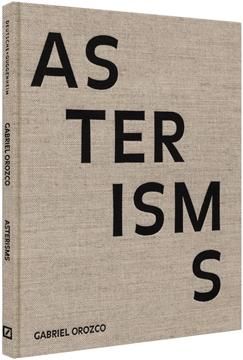Currently Reading: Gabriel Orozco – Asterisms (exhibition catalogue). 2012. Guggenheim Museum Publications, New York.
Nancy spector (curator)’s essay begins by comparing stroturf Constellation and Standstars – two rubbish collections from a playing field in America and beach in Mexico respectively; two areas where Orozco splits his time between.
Spector mentions a few previous rubbish projects: Penske Work Project (1998) which “involved a performance process in which the artist drove around New York City in a rented moving van, stopping at dumpsters to rummage for materials from which he crafted on-the-spot sculptures that he stored in the back of the vehicle. […] A year later, Orozco embarked on a similar project of retrieval and display by gathering the rusted cans that littered a beach in the Mexican state of Oaxaca and transforming each one with a label from the local beer, Carta Blanca. Corroded beyond use value, these cans found renewed purpose when exhibited at Portikus in Frankfurt as part of Carta Blanca (1999), an installation pairing beer, industrial decrepitude, and sand. (p.68)
In footnote 6 (p.69) Spector cites Benjamin H. D. Buchloch on Orozco’s work comparing Schwitters and Arp: “The affirmation of an object’s presentness and use value was countered by … Dadaists Arp and Schwitters with an emphasis on obsolescence, the object’s slow deterioration, or its inherent, increasingly rapid disappearance. Once of the precarious tasks that Schwittters and Arp confronted was of course to distinguish the obsolete object from mere detritus. That is, to transfigure an object, merely freed by time from its deployment in the production of use and exchange value, so that it could become a mnemonic object, engendering a reflection on the imaginary status not only of a future object, but also of future subject/object relations freed from all elements of production. What we perceive as aesthetic mastery in Schwitters and Arp originates first of all in their ability to rescue the fragments as mere junk, and to imbue the obsolete within an act of redemption.” – quoted from Gabriel Orozco: Sculpture as Recollection. 2006. Mexico City Museum del Palacio de Bellas Artes/Turner. p.168.
As I do with the Museum of Contemporary Rubbish photographs; “He isolated every item against a neutral backdrop, focussing it in the center of the frame.” p.69
Ans also in parallel with my notion that classification systems (including classifying something as rubbish) are human constructs: “The centrality of man is also obvious when it comes to taxonomic thought, given that all classified systems are ultimately subjective and arbitrary. They only exist as reflections on our heuristic perspectives on the natural world. With Asterisms and its taxonomic inflection, Orozco has emptied the archival model of its tacit authority by veiling his voice, his own subjectivity, behind the overarching logic of categorization – no matter how contrived the system – no ultimately reveals its artificiality.” (p.70)

